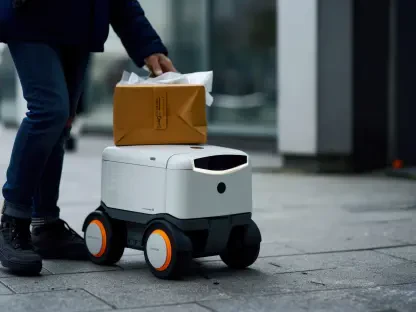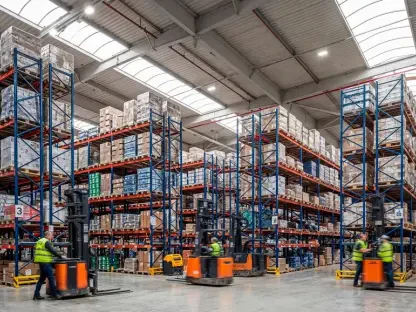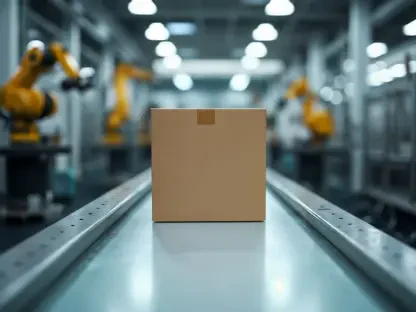The drive toward automation in modern industries is gathering momentum, with artificial intelligence (AI) leading the charge in transforming warehousing and governance across the globe. In this environment of rapid change, Symbotic emerges as a beacon of innovation. Its advanced AI-powered robotics solutions not only reshape how warehouses manage inventory but also suggest transformative potential within public sector logistics.
In warehousing, traditional processes have historically been labor-intensive and resource-heavy. The industry today stands at a critical junction where the integration of AI technologies is both a necessity to remain competitive and a challenging endeavor. The primary segments of warehousing see the involvement of major retailers striving to emulate the automation prowess of leaders like Amazon. Meanwhile, governance sectors observe the technological evolution from a distance, weighing the benefits of AI applications against longstanding bureaucratic procedures and regulations.
Trends and Projections in AI-Driven Transformation
Key Trends Shaping the Industry
AI is changing the landscape of both warehousing and governance, dictating new norms and practices. The advent of autonomous solutions like those from Symbotic ushers in a wave of efficiency, facilitating seamless inventory management for major retailers such as Walmart and Albertsons. The success of these systems underscores a broader consumer-driven demand for faster and more efficient delivery services. Consequently, industries are pivoting toward adopting AI technologies that optimize operations and meet heightened expectations.
The emergence of AI in public governance is not merely a speculative notion. Movements advocating for technological integration signal a broader societal acceptance and readiness for more streamlined and cost-effective government services. The alignment of such initiatives suggests an impending shift towards automation in governance structures, hinting at a future where public sector reforms could mimic the private sector’s tech-first approach.
Market Data and Future Forecasts
The delivery of AI-based solutions in warehousing is showing promising market growth. Recent statistics project continued momentum in AI investments, bolstered by rising demands from the e-commerce sector. Symbotic’s influence within this market is significant, as they harness AI to redefine operational benchmarks. Looking ahead, forecasts suggest a substantial shift in market dynamics as more industries, including governance, turn toward intelligent, automated solutions to drive progress and efficiency.
Future projections reveal a sustained upward trend in AI adoption across various domains. The logical extension of current trajectories places Symbotic in a favorable position to capitalize on a multi-trillion-dollar market. This expansion is expected to impact both warehousing efficiencies and public sector logistics, heralding an era of intelligent machinery across diverse industries.
Challenges in AI Integration and Overcoming Them
Despite the favorable outlook, AI integration in warehousing and governance presents distinct challenges. Technologically, the complexity of adapting existing systems to AI-friendly frameworks cannot be understated. The balance between autonomy and oversight remains a delicate issue, particularly in governance, where transparency is paramount.
To overcome these obstacles, industries are encouraged to adopt a phased approach towards AI implementation. Collaboration between stakeholders can create an environment conducive to innovation and adaptation, while ongoing evaluation ensures balanced integration with existing regulatory frameworks. Forward-thinking strategies, therefore, focus on blending AI capabilities with practical oversight, maintaining compliance, and achieving operational targets.
Regulatory Environment for AI in Warehousing and Governance
Navigating the regulatory landscape is a critical component of AI adoption. Current regulations in warehousing and governance emphasize compliance, security, and privacy standards. Symbotic and similar enterprises must continuously align their innovations with these statutory requirements to maintain legitimacy and operational integrity.
As regulatory bodies introduce new standards, the onus is on industry players to adapt their practices while advocating for effective and fair policies. These updates in regulations aim to protect both consumers and companies, ensuring AI innovations contribute positively to society. The ongoing dialogue between technology providers and regulators will shape the trajectory of AI integration across both private and public sectors.
Future Directions and Opportunities
Looking ahead, the horizon for AI in warehousing and governance is one of immense opportunity. Technological advancements in robotic automation, data analytics, and AI-driven processes offer transformative potential across industries. The anticipated growth in AI capabilities suggests not only improved efficiency but also the creation of new job sectors focused on oversight and AI management.
Symbotic, leveraging its technological leadership, stands to benefit from these shifts, with a strong foothold in both automation and governance reform initiatives. The continued intersection of AI and industry will redefine work dynamics, reshape consumer expectations, and open new avenues for economic growth.
Conclusion and Recommendations
As AI technology propels industries forward, the role of companies like Symbotic becomes increasingly vital. Findings point to AI’s profound impact on operational efficiencies and strategic value across sectors. Future approaches should incorporate flexible AI frameworks that align with evolving regulations, ensuring technology serves both business goals and societal needs.
Strategic investments in AI-driven infrastructure will facilitate sustained growth and unlock new potential in warehousing and governance. By remaining at the forefront of innovation, companies can capitalize on expanding markets and drive the AI revolution in tangible, impactful ways.









